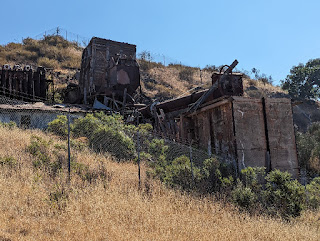Our guide led us on a modest hike, framing his narrative across three periods of human activity. First, that of the native Ohlone people—who dusted themselves with the red ore they dug from a cave. Next came the settlers who recognized that ore for what it is (cinnabar) and what it yields (mercury). Finally, to the modern era: environmental work to clean up the toxic aftermath of the mining and restore the land to a more natural state.
When I moved to this area, I have a vague memory of being advised against hiking in this park on warm summer days, to avoid any latent vapors rising from the soil. True? Maybe not. But it is true that the local waterways are clearly posted with warnings not to eat any of the fish (due to high levels of mercury).
I had not realized that there were structures still standing.
Maybe some things are best left undisturbed? Evidently this rotary furnace was used until 1976, which seems ... recent, even though nearly 50 years have passed. As incongruous as it is, it made sense to build it here to process the ore on site rather than transport the raw material elsewhere. (Unfortunatley with little or no awareness of the ensuing contamination.)Crushed ore was heated to release mercury vapor, which condensed in the system of pipes to be collected in liquid form. One thing that didn't get discussed today was the health impact on those who worked with these substances.
Trees were felled to feed the furnaces. Large, isolated trees likely marked the former sites of workers' homes. I was intrigued by a blooming plant that seemed both familiar, and yet unfamiliar. It turned out to be Spanish broom (invasive). As we were near the area known as “Spanish Camp,” that made sense: residents must have introduced it. As we retraced our route along Wood Road, our guide revealed that the meadow we crossed was also the result of human activity: a hill had been leveled for soil to cap the area where the contaminated materials had been moved (location undisclosed and off-limits, within the park).The hike was short on distance (less than four miles) but long on learning: cultural, historical, and chemical (how mercury is used to extract gold).







No comments:
Post a Comment